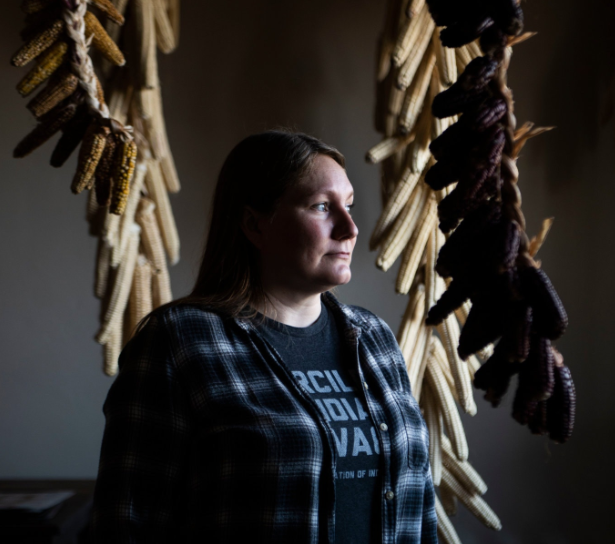How Native Americans Are Fighting a Food Crisis
原住民抗擊糧食危機(jī)
For the roughly 20,000 members of the Oglala Sioux Tribe living on the Pine Ridge Indian Reservation —
松嶺印第安保留地是南達(dá)科他州南部幅員200萬英畝的一片廣袤土地,
a vast, two million-acre expanse in southern South Dakota —social distancing is certainly feasible.
對于居住在這里的近2萬名奧格拉蘇族部落成員來說——保持安全距離當(dāng)然沒有問題。
Putting food on the table? Less so.
但保證三餐就不是那么回事了。
Getting to food has long been a challenge for Pine Ridge residents.
對松嶺地區(qū)的居民來說,獲取食物歷來都是一大考驗(yàn)。
For a lot of people, the nearest grocery store is a two-hour drive away.
當(dāng)?shù)赜胁簧偃司嚯x最近的超市都有兩小時(shí)車程。
Many rely on food stamps or the Food Distribution Program on Indian Reservations,
很多人維持生計(jì)都要依靠靠食品券或印第安保留地食品配送——
a federal initiative that provides boxes of food (historically lacking in healthy options) to low-income families.
為低收入家庭提供食盒(一直都缺乏健康選擇的盒裝食品)的一項(xiàng)聯(lián)邦政策。
Diabetes rates run very high.
正因?yàn)槿绱耍?dāng)?shù)靥悄虿“l(fā)病率頗高。
The coronavirus crisis — one case has been reported on the reservation — has only made access to food harder,
新冠肺炎疫情——該保留地也報(bào)告了一例確診病例——爆發(fā)后,為數(shù)不多的食品貨架變得空空如也,
as shelves of the few groceries empty out, shipments of food boxes are delayed because of supply chain disruptions,
食盒供應(yīng)鏈中斷配送延誤,加之狩獵和采集受到了政府法規(guī)和環(huán)境條件的限制,
and hunting and gathering are restricted by government regulations and environmental conditions.
當(dāng)?shù)卦∶瘾@取食物的難度進(jìn)一步加大。

But the Oglala Sioux, like many other Native Americans across the country, are relying on the practices — seed saving, canning, dehydrating —
好在,和其他地區(qū)的原住民一樣,奧格拉蘇族部落也開始回歸留種、制作罐頭、脫水等傳統(tǒng)經(jīng)驗(yàn),
that their forebears developed to survive harsh conditions, with limited supplies.
他們的祖先便是憑借這些經(jīng)驗(yàn)在食物有限的情況下度過了一個(gè)又一個(gè)艱難時(shí)期。
“It is kind of a Catch-22 to be so well-adjusted to react to threats,” said Jamie Azure, the tribal chairman of the Turtle Mountain Band of Chippewa, in Belcourt, N.D.
“面對威脅,我們迅速做好了調(diào)整,結(jié)果反倒讓人有點(diǎn)左右為難了,”北卡羅來納州貝爾考特奇佩瓦龜山部落的部落首領(lǐng)杰米·阿祖爾說道。
“You’re forced to stay in a specific area, you’re told to trust the government, you’re told food will be scarce — welcome to 1700s Native nation.”
“他們強(qiáng)制要求你待在某個(gè)特定的區(qū)域內(nèi),告訴你你要相信政府,告訴你食物會(huì)短缺——?dú)g迎來到17世紀(jì)原住民的世界。”
Big-box stores and processed foods have eroded some of the old customs.
大賣場和加工食品已經(jīng)蠶食了奧格拉蘇族的部分傳統(tǒng)。
But now, faced with a disrupted food system, many Native Americans are looking to those traditions for answers.
面對當(dāng)下混亂的食品體系,許多尋找出路的原住民便開始將目光轉(zhuǎn)向了這些傳統(tǒng)。
Milo Yellow Hair, who lives in Wounded Knee, S.D., on the Pine Ridge Reservation,
為了大家能在自家園子順利下種,家住南達(dá)科他州松嶺保護(hù)區(qū)“傷膝”地區(qū)的黃毛米洛
is hard at work preparing 8,000 seedlings of local varieties of squash and corn — hearty crops with a short growing time — to plant in people’s yards.
正忙著為當(dāng)?shù)鼐用駵?zhǔn)備8000株當(dāng)?shù)仄贩N的南瓜和玉米幼苗——這些都是成熟時(shí)間短,產(chǎn)量還豐富的作物。
Many residents live without electricity to run refrigerators or freezers,
由于許多居民家中都還沒通上能夠供應(yīng)冰箱或冰柜的電力,
so to prepare for what could be weeks or months of staying indoors,
為了應(yīng)對接下來或?qū)⒊掷m(xù)數(shù)周乃至數(shù)月的居家隔離生活,
he is encouraging people to dry their vegetables so they’ll keep for a while.
米洛正在鼓勵(lì)大家晾制能夠長期保存的干菜。
Corn, for example, can be cooked and dried to be used as a base for soups and stews,
玉米可以煮熟烘干,為湯或燉肉打底,
or to make wagmiza wasna, a traditional snack in which the corn is pounded with berries and tallow.
也可以和漿果、牛油一起搗碎,制成當(dāng)?shù)氐膫鹘y(tǒng)零食wagmiza wasna。
“Here on the reservation it is a day-by-day existence,” said Mr. Yellow Hair, 70, who works for the nonprofit Slim Buttes Agricultural Development Program.
“我們保留地的日子都是過一天算一天,”已經(jīng)古稀之年卻仍在公益組織“瘦嶺農(nóng)業(yè)發(fā)展計(jì)劃”工作的米洛說道。
“If this thing goes crazy and the external food services stop,
“如果疫情失控,外面的食品配送也不送了,
the food we grow locally is going to be paramount to meet this need.”
我們自己種的糧食就能在食物供應(yīng)方面發(fā)揮首要作用了。”
譯文由可可原創(chuàng),僅供學(xué)習(xí)交流使用,未經(jīng)許可請勿轉(zhuǎn)載。












